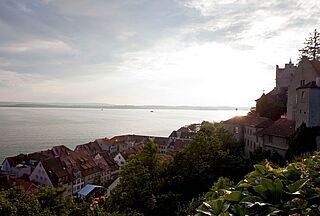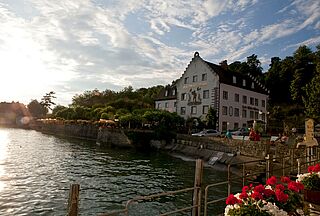Elisabethenberg and Olgaberg
Kendte vinmarker
Princess Elisabeth and Queen Olga-Württemberg Royals are Namesakes of Germanys Highest Vineyards
The Bodensee (Lake Constance) forms a border between Germany, Switzerland and Austria. Some 30 km/20 miles northwest of the lake lies the Hegau district of Germany, home of a chain of extinct volcanoes, the highest of which is Hohentwiel. Depending on where it is measured, the cone-shaped hill ranges in height from 630 to 707 meters / 2,067 to 2,320 feet. Two vineyard sites Elisabethenberg and Olgaberg, planted at heights between 520560 meters /1,7061,836 feet share the steep slopes of the Hohentwiel Berg (hill or mountain) with a Bannwald, a primeval forest and nature reserve since 1941 capped with one of Germanys largest castle ruins, Hohentwiel fortress, nearly 10 ha/25 acres in size.
Fire and Ice
After volcanic eruptions millions of years ago in the Hegau district, deposits of volcanic ash and stone built up on their exterior slopes. At a later stage, magma rose to the surface of the volcanic vents, but cooled and hardened inside before actually erupting – thereby forming a “plug” or cap that proved to be quite resistant to the millions of years of erosion that followed. Erosion ultimately sculpted the shape of the volcanoes. Glacial movement during the ice age shaved off the outmost layers of ash, leaving the cone-shaped hills that are visible today.
Twiel – the Rock
The not unlike their weathered slate counterparts (e.g. Ahr, Mosel and Mittelrhein valleys) in terms of their ability to quickly absorb heat during the day and gently release it during the night, thereby creating a microclimate in which grapes can thrive, even in this northerly location. The wines produced from the grapes grown on the slopes of Twiel were originally known as “Twieler” wines. Much later, they took on the individual site names Elisabethenberg and Olgaberg. The former is solely owned by Weingut Vollmayer in Hilzingen, a town at the western foot of the hill; the latter is solely owned by the Staatsweingut Meersburg, headquartered in Meersburg on the shores of the Bodensee, about an hour’s drive from Hohentwiel.
Both sites have excellent exposure: Elisabethenberg faces south-southwest; Olgaberg, south-southeast. Weathered volcanic soils topped with a layer of humus predominate in both sites, but the upper reaches of the Elisabethenberg include a mixture with tuff that makes for a very thin, but mineral-rich, soil. The vines on Hohentwiel lie very close to the rocky underground and thus, the wines often have a very pronounced mineral – or even salty – tone. According to Marion Schäfer of the Staatsweingut Meersburg, consumers describe the taste of Olgaberg wines “reminiscent of powdered stone.”
Both vineyards are quite steep (the bottom reaches of Elisabethenberg are sloping) and both have undergone a terracing project during the past decade to make vineyard maintenance somewhat easier/more economical.
Hohentwiel’s Viticultural Tradition
Vines have been cultivated in the Bodensee and Hegau districts of southern Baden for at least as long ago as Roman times. At the hand of the Franks and later, the church and the nobility, viticulture flourished. The first documented mentions of viticulture vary considerably, but often were registered in deeds of gift to monasteries. Furthermore, wherever churches or monasteries were located, there was a need for wine for mass. Considering the founding of the St. Georgen monastery on Hohentwiel in 970 and the difficulties of transporting provisions to the steep hillside site, it is not unreasonable to assume that vines were cultivated on site to supply the needs of the monastery. The Abbey of St. Gallen owned Hohentwiel from 1086 until the early 12th century. The prince bishops of Constance had documented vineyard holdings in the area since 1200. After secularization in 1802–03, their vineyards were transferred to the state (ultimately the state of Baden-Württemberg).
Many vineyards were abandoned in the wake of the Thirty Years’ War (1618–1648) – there were too few survivors to tend the vines. Even more devastating, perhaps, were the unwelcome American imports phylloxera (vine louse) and fungal diseases (mildew) in the late 19th century. They wiped out large tracts of vineyards and for several years, vines were no longer cultivated on Hohentwiel. Some of the former vineyards were replanted with orchards.
After World War I, Robert Vollmayer, a chef and sommelier, and his wife moved to Hohentwiel and leased the hillside restaurant at the Hohentwiel domain. After researching the records of Twiel’s viticultural past, he opted to lease some of the land on the south-southeastern-facing slope (Olgaberg) to cultivate vines. Prior to World War II, he lost his lease on that land and then decided to replant the south-southwestern-facing slope (Elisabethenberg) with vines. From Robert Vollmayer’s initial 4 ha/ca. 10 acres of vines, his son increased the vineyard area to 6.3 ha/15.6 acres, and in 1962, moved the winery from the Hohentwiel domain to Hilzingen, on the western foot of the hill. From 1963–1968, orchards were replanted with vines, thereby increasing the size of the estate to nearly 15 ha/37 acres. Today, it is operated by the third generation: Georg and Beate Vollmayer. In all, Robert Vollmayer can be viewed as the pioneer responsible for the rebirth of viticulture on Hohentwiel.
Hohentwiel Wines Today
The following grape varieties are cultivated on Hohentwiel:Elisabethenberg (ca. 15 ha/37 acres): Müller-Thurgau 30%, Spätburgunder/Pinot Noir 25%, Riesling and Grauburgunder (Pinot Gris) 15% each, Weissburgunder (Pinot Blanc) 5%, as well as small amounts of Bacchus, Dornfelder, Regent, Cabernet Dorsa and Chardonnay.Olgaberg (6.5 ha/16 acres): Müller-Thurgau 31%, Spätburgunder 26%, Weissburgunder 19%, Riesling 15%, and a tiny amount of Sauvignon Blanc.
Clearly, Müller-Thurgau and Spätburgunder are the leaders here – as in the sites along the Bodensee, home of the so-called “Seeweine” or “lake wines.” Spätburgunder is most often vinified as a Weissherbst (rosé). The wines, both red and white, have a lively acidity and are refreshingly light.
The Hohentwiel Vineyards in Baden – The Württemberg Connection
There is evidence of settlements at the bottom of the hill as long ago as 5 BC and the upper reaches of the hill were doubtlessly used by the Romans as an outlook and/or bulwark, but it wasn’t until the early 10th century that the first fortress was built at the top of the hill, by Burkhard II, Duke of Swabia. His successor, Burkhard III (919–973), enlarged the structure and converted it into a ducal residence. He and his wife Hadwig (939–994) – a well-educated and politically savvy woman of her time – also had the St. Georgen monastery built on the grounds in ca. 970, to foster both religion and education. The Swabian duchy lost its influence at Hohentwiel when King Heinrich II had the monastery relocated to Stein am Rhein in 1005. Subsequent ownership passed back and forth among numerous local aristocrats until the 16th century.
In 1519, Ulrich, Duke of Württemberg (1487–1550) was forced into exile and sought refuge in Switzerland and later at Hohentwiel, which he temporarily appropriated from the von Klingenberg family in 1521, promising to return it to them as soon as he reconquered his duchy. Ulrich successfully reclaimed his duchy in 1534, but did not keep his part of the bargain. In 1538, the von Klingenbergs were more or less forced to permanently renounce their claims to ownership. It was during this time that Hohentwiel became a Württemberg enclave within the territory of Vorderösterreich (Habsburg holdings in Alsace, Vorarlberg and southern Baden). Under Ulrich and his son Christoph, the residential quarters of Hohentwiel were rebuilt into a three-wing Renaissance castle. The last expansion of the property took place in 1735, but the majority of the nearly 10-ha / 25-acre ruins that remain today date from Duke Ulrich’s reign. Hohentwiel was besieged many times over the centuries – but never defeated. Its demise came on orders from Napoleon, whose troops blasted it into ruin in 1800/1801. Despite its distance from Tuttlingen, Hohentwiel was “incorporated” into this southern Württemberg outpost between 1830 and 1850, and thus remained a Württemberg enclave within Baden until it was joined with the Baden town of Singen, on the eastern foot of the hill, in 1969.
Elisabeth and Olga
It is assumed, but cannot be documented, that the names of the two individual sites on Hohentwiel are based on Princess Elisabeth and Queen Olga – both were Württemberg royals. Why the vineyards took on their names remains a mystery to this author. Nevertheless, who were these women?
Elisabeth. In all probability, she is Elisabeth Friederike Sophie, Princess of Brandenburg-Bayreuth (1732–1780), a niece of the King of Prussia and daughter of Friedrich von Brandenburg-Bayreuth. She is said to have been strikingly beautiful. In 1748, she married the 12th Duke of Württemberg, Carl (Karl) Eugen (1728–1793). Their daughter, Princess Friedericke von Württemberg, was born in 1750 and died in infancy. The marriage was not a happy one. Elisabeth returned to her family in Bayreuth in 1756, where she remained for the rest of her life. After her death, Carl Eugen remarried his longtime lover, the divorcée Franziska von Leutrum.
Olga. A daughter of Czar Nicholas I and Princess Charlotte of Prussia, Grand Duchess Olga Nikolajewna Romanowa (1822-1892) married Karl I (1823–1891), future King of Württemberg in 1846. He was the son of King Wilhelm I, and inherited the throne in 1864. Olga was a well-educated and active supporter of social causes, e.g. care of handicapped and war veterans, education of young women, and was the patron of a children’s hospital in Stuttgart (Olgäle).
Tips for Tourists:
- The Vulkanpfad (volcanic path), a 3-km/ca. 2-mile path along the hillside, starting midway up the hill, offers hikers an opportunity to learn more about the geological, botanical and zoological makeup of the hill. Hohentwiel provides a home for rare flora and fauna that are normally found in southern Italy or northern Africa.
- The massive ruins of Hohentwiel fortress and the info center in the former coach house are open year-round. Ask for the English-language brochure “The Hohentwiel History Trail.” In spring of 2007, the Staatsweingut Meersburg plans to open a wine shop on the grounds. From the fortress ruins there are views of the Bodensee, the Alps, and the Black Forest (weather permitting). The English-language pages of www.schloesser-magazin.de provide a wealth of interesting information about Hohentwiel.
- Also midway up the hill is the Hohentwiel domain, where Dr. Hubertus Both and Hanne Pföst tend herds of sheep and goats and operate the Hofladen, a shop that sells wine, juice, brandy, hancrafted items as well as sausage and ham from the sheep who graze on the hill. The shop is open Wednesday, Thursday and Friday evenings (5–7 p.m.) and Saturdays (10 a.m.–4 p.m.).
- The tourist information office in Singen can organize tours and provide additional information. The annual Hohentwiel festival (early July) features musical entertainment. Telephone: +49 (0)7731/85262. www.singen.de
- There is a small hotel (1 single, 10 double rooms and 2 apartments) and restaurant with a terrace and beer garden on the hill: Hotel-Restaurant Hohentwiel. Telephone: +49 (0)7731/99070. www.hotel-hohentwiel.de
- Last but not least: nearby sights that are well worth a visit: the island of Reichenau (UNESCO World Heritage site), the “flower island” of Mainau, and the towns of Konstanz and Meersburg.
Many thanks to Marion Schäfer, Staatsweingut Meersburg, for background info and supplying photo material. www.staatsweingut-meersburg.de
And to Beate Vollmayer, Weingut Vollmayer, who went to great efforts to try to help solve the mystery of the identity of Elisabeth, namesake of the estate’s vineyard. www.vollmayer-weingut.de


